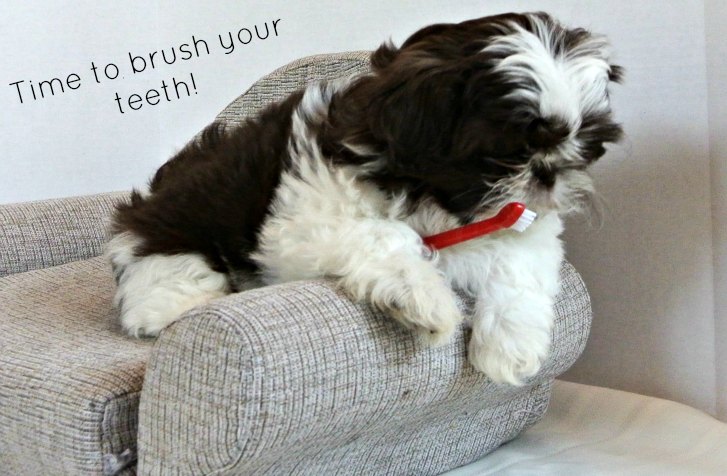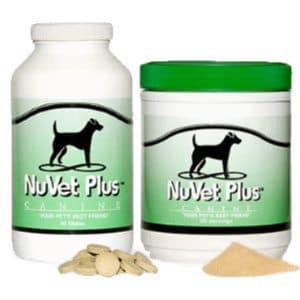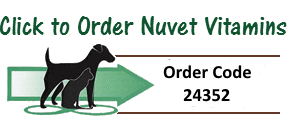Your Shih Tzu Puppy Dental Care Guide
by Janice Jones
Why not start off right with a puppy dental care plan.
You’ll be glad you did, not only to keep those teeth shiny and breath smelling clean, but to also prevent costly dental visits to your vet later on.
Puppy Dental Care Primer
A puppy is born toothless, but in three, to four weeks, the teeth begin to come in. Some baby teeth erupt sooner, some later. They start with the incisors, then the canine and premolars. They do not get molars until the adult teeth erupt.
A puppy will keep these baby teeth until about the age of 4 or 5 months when they begin to lose them as the adult teeth gradually come in.
Just like human babies, puppies lose their teeth gradually. By 3 months, some of the puppy’s incisors begin to fall out. You will begin to see the adult canine teeth and molars start to emerge.
By 7 to 8 months, all adult dog teeth have replaced the puppy teeth leaving the dog with a mouthful of 42 adult dog teeth. The lovely aroma of puppy breath disappears when the adult dog teeth replace the baby teeth.
Do not worry if you do not find any baby teeth because most of the time the puppy swallows them. This is not harmful and no cause for alarm. Occasionally adult dog teeth come in where the baby teeth have not fallen out. In these cases, veterinarians will often remove the baby teeth during the time when the puppy is spayed or neutered.
What are some signs and symptoms of puppy teething?
I assume there is much discomfort involved with teething, but I have never witnessed the whining, crying and other behaviors that often accompany a human infant’s teething pain. You will know that the puppy is teething because they will want to gnaw on everything and most find human fingers irresistible. There are also some tell-tale signs your puppy is teething:
- Bleeding or swollen gums
- Chewing on furniture, woodwork, toys, human fingers and anything else they can find to munch on
- Drooling (yes, I've seen some Shih Tzu puppies drool
- Poor appetite
- Missing Teeth
Why Start a Puppy Dental Care So Young?
One of the best ways to prevent dental problems is to start early even when the puppy still has his baby teeth.
Years ago, people believed that the way to keep a dog’s teeth clean and sparkling was to feed a good kibble, supplement with dog biscuits and provide rawhide bones. We now know that this is not enough –good puppy dental care can prevent tooth decay and bacterial infections from entering the bloodstream and causing great pain for your dog.
The more often you brush your dog’s teeth, the better, but, if you can’t brush every day, set a goal for a couple times per week.
When to Start a Puppy Dental Care Program
Don't wait until the adult dog teeth come in. Begin right from the start. Puppies need care too and it is never too early to start brushing their teeth. Start out with very short session as soon as you obtain your dog.
Before you can brush or clean a puppy's teeth, a puppy must tolerate and allow you to open their mouth and view their teeth. It is the first step and a very important one. It is also a behavior that does not come naturally to many puppies.
What is the best way to open a puppy's mouth?
It is not always easy to open the mouth of a Shih Tzu puppy. Their anatomy alone makes it difficult. Large heads and flat faces means that you need big steady hands just to get around that lovely round head. Combine that anatomy with a squirmy puppy, and you have yourself a little challenge.
The best way to open their mouth is to place your thumb and forefinger just behind their canine teeth, slowly lift their head backward and open their mouth with your other hand. Talk gently to your puppy while you do this, praise and scratch her ears or chin. Finish with a treat.
I know this sounds like a slow process but it will pay dividends in the end and make brushing much easier. It will also make trips to the vet easier because your vet will want to check her mouth during routine office visits.
Puppy Dental Care: How To
Now it's time to get serious with your puppy dental care program. What will you need to get started? There is more than one way to brush a dog's teeth. The most obvious is a toothbrush with dog toothpaste. But you may need to work up to this step by step.
Before you add a toothbrush, to your routine, consider placing a small amount of doggie toothpaste on your index finger and massaging the puppy's gums gently. Once puppy has accepted a human finger into his mouth, you are ready to introduce a tooth brush, finger brush, wipe or spray.
Puppies are squirmy and are likely
to resist your efforts, so the first couple of sessions might consist of an
introduction to the toothpaste and toothbrush. The puppy’s first reaction
to tooth brushing is most likely going to be a propensity to chew on the
brush.
Once you feel your puppy is ready gently go over his teeth, as you would your own, in a circular manner from the gums to the ends of the teeth. It’s easier to work on the side of the teeth closest to the gums and that is where most of the tartar accumulates.
Do not worry too much if you cannot get to the other side of the tooth. If you do this on a regular basis, your dog will begin to tolerate it better and you can take the time to inspect the mouth for other potential problems.
If your puppy resists the toothbrush, you have several other options. Rubber finger brushes work well in tiny mouths. You can also purchase dental wipes that you can use to wipe down the teeth and gums.
Here’s detailed information on canine toothpastes.
If you prefer, you can also use small gauze square sprinkled with a dab of toothpaste. This might be the easiest way to transition to the toothbrush because the puppy becomes accustomed to the taste of toothpaste.
Here are a couple inexpensive puppy dental care products to check out.
Dog toothpaste comes in dog-friendly flavors such as liver or chicken flavored paste. Yuk, but I'm sure the dog loves it. NEVER use a human toothpaste on your dog. Human toothpastes contain xylitol which is toxic to dogs. Many others also include fluoride, which is also poisonous to dogs. Here are some options you may want to consider. Go with a flavor your puppy likes. For example, if he's eating chicken dog food, he's likely to enjoy a chicken flavored toothpaste.
Hints to Make Puppy Dental Care Easier
- Offer your puppy human treats such as veggie sticks or fruit. Puppies generally like carrot sticks, apples, or even raw green beans. Don't force the issue if this isn't on your puppy's favorite foods list.
- Try a dental chew. These are good crate training treats especially at night when you want your puppy to go to bed. Chewing on a dental stick will keep his mind off being in the crate and relax him so he will fall asleep.
- Some chew toys also double to help keep teeth clean
- What about dental sprays? I've used several on dogs that just refuse any form of tooth brushing and they have worked for me moderately well. For some, it is just a matter of adding a few drops to the dog's water. Others can be sprayed directly on their gums or teeth. I personally do not think they replace teeth brushing, but that's just my opinion.
Most people agree that dental problems are worse in small breed dogs, so caring for those canine teeth from the very beginning is the best way to save costly trips to the veterinarian for professional cleaning.
"Hi, I'm Janice Jones, a former veterinary technician and Shih Tzu expert with over 40 years of experience with the breed. Through Miracle Shih Tzu, I combine my medical background and extensive breed knowledge to provide reliable, practical advice for Shih Tzu owners. My mission is to help you give your Shih Tzu the happiest, healthiest life possible through evidence-based information and real-world solutions. Whether you're new to the breed or a seasoned owner, you'll find trusted guidance here for all aspects of Shih Tzu care.
I hold an undergraduate degree in Psychology with a minor in biology, Early Childhood Education, and Nursing, and a Master's in Mental Health Counseling.




